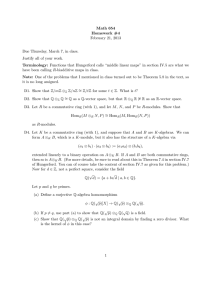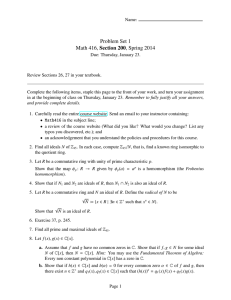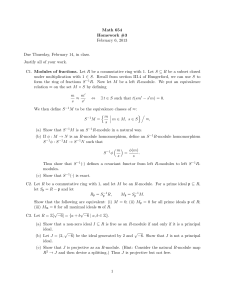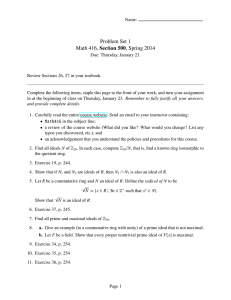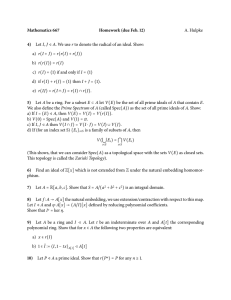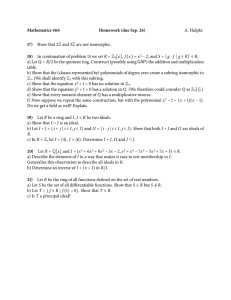Chapter 6, Ideals and quotient rings Ideals. Finally we are ready to
advertisement
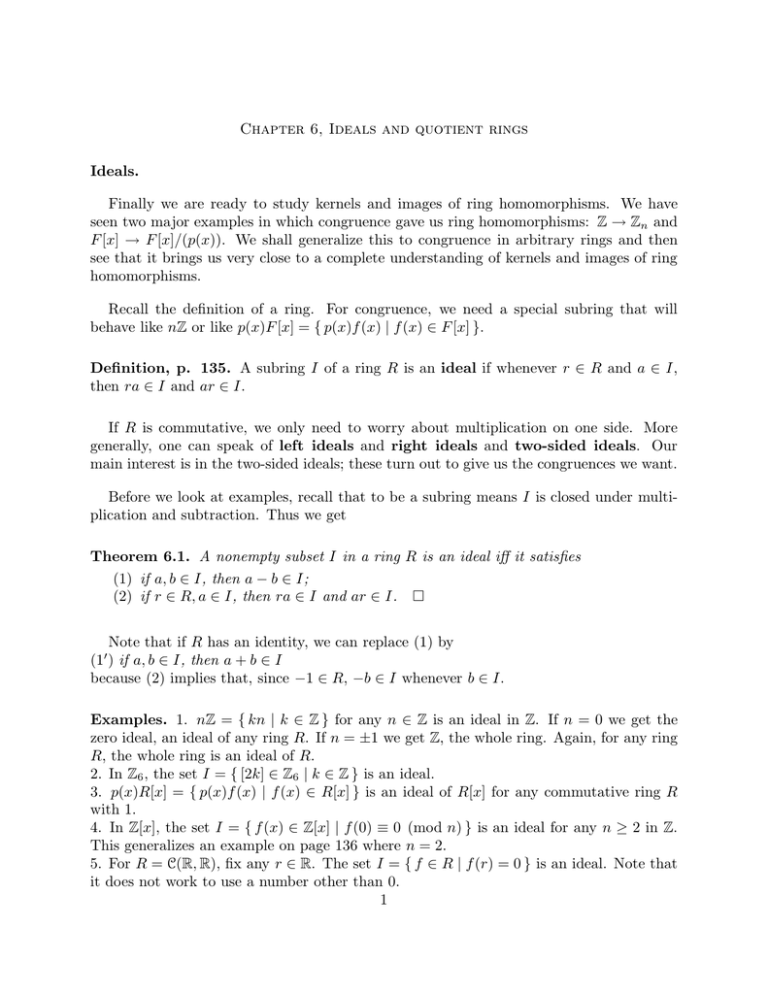
Chapter 6, Ideals and quotient rings
Ideals.
Finally we are ready to study kernels and images of ring homomorphisms. We have
seen two major examples in which congruence gave us ring homomorphisms: Z → Zn and
F [x] → F [x]/(p(x)). We shall generalize this to congruence in arbitrary rings and then
see that it brings us very close to a complete understanding of kernels and images of ring
homomorphisms.
Recall the definition of a ring. For congruence, we need a special subring that will
behave like nZ or like p(x)F [x] = { p(x)f (x) | f (x) ∈ F [x] }.
Definition, p. 135. A subring I of a ring R is an ideal if whenever r ∈ R and a ∈ I,
then ra ∈ I and ar ∈ I.
If R is commutative, we only need to worry about multiplication on one side. More
generally, one can speak of left ideals and right ideals and two-sided ideals. Our
main interest is in the two-sided ideals; these turn out to give us the congruences we want.
Before we look at examples, recall that to be a subring means I is closed under multiplication and subtraction. Thus we get
Theorem 6.1. A nonempty subset I in a ring R is an ideal iff it satisfies
(1) if a, b ∈ I, then a − b ∈ I;
(2) if r ∈ R, a ∈ I, then ra ∈ I and ar ∈ I. Note that if R has an identity, we can replace (1) by
(1 ) if a, b ∈ I, then a + b ∈ I
because (2) implies that, since −1 ∈ R, −b ∈ I whenever b ∈ I.
0
Examples. 1. nZ = { kn | k ∈ Z } for any n ∈ Z is an ideal in Z. If n = 0 we get the
zero ideal, an ideal of any ring R. If n = ±1 we get Z, the whole ring. Again, for any ring
R, the whole ring is an ideal of R.
2. In Z6 , the set I = { [2k] ∈ Z6 | k ∈ Z } is an ideal.
3. p(x)R[x] = { p(x)f (x) | f (x) ∈ R[x] } is an ideal of R[x] for any commutative ring R
with 1.
4. In Z[x], the set I = { f (x) ∈ Z[x] | f (0) ≡ 0 (mod n) } is an ideal for any n ≥ 2 in Z.
This generalizes an example on page 136 where n = 2.
5. For R = C(R, R), fix any r ∈ R. The set I = { f ∈ R | f (r) = 0 } is an ideal. Note that
it does not work to use a number other than 0.
1
2
a b 6. For R = M2 (R), the set of first rows I =
a, b ∈ R is a right ideal but not
0 0 a left ideal. (A similar thing is done for columns and left ideals in the book.) In particular,
I is not a (two-sided) ideal. Check.
Examples 1, 2 and 3 above were all of a special type which we can generalize.
Theorem 6.2. Let R be a commutative ring with identity. Let c ∈ R. The set
I = {rc | r ∈ R } is an ideal of R.
Proof. Given two elements r1 c and r2 c in I, we have r1 c − r2 c = (r1 − r2 )c ∈ I. For any
a ∈ R, a(r1 c) = (ar1 )c ∈ I. Therefore I is an ideal. (We have implicitly used the fact that
R is commutative so that multiplication on the right also works.) We call the ideal in Theorem 6.2 the principal ideal generated by c and denote it
by (c) or by Rc. The ideal in Example 4 was not principal. To see this, note that n ≥ 2
and x both lie in I. If I were generated by some polynomial p(x), then both n and x must
be multiples of p(x). But then n = p(x)q(x) implies that p(x) is a constant c. Note that
c 6= ±1, for that would make I the whole ring, which it is not since 1 ∈
/ I. Now we also
have x = cr(x) for some r(x), which is impossible since c does not divide x (i.e., c has no
inverse in Z[x] since the only units are ±1). In fact it is easy to see that I is generated by
the two elements n and x in the sense of the next theorem.
Theorem 6.3. Let R be a commutative ring with identity. Let c1 , c2 , . . . , cn ∈ R. Then
the set I = {r1 c1 + · · · + rn cn | r1 , . . . , rn ∈ R } is an ideal of R.
Proof. Homework; generalize the proof of Theorem 6.2. We call the ideal I of Theorem 6.3 the ideal generated by c1 , . . . , cn and denote it
by (c1 , c2 , . . . , cn ).
Comments. 1. If R does not have an identity, there is a complication in the definition
since one wants the elements ci ∈ I (see exercise 31, p. 143).
2. If R is not commutative, one needs multiplication on both sides in the definition of I.
3. Ideals with finitely many generators are called finitely generated ideals. One has to
work a bit to find ideals which are not finitely generated and we will avoid them in this
course. One example is the ideal generated by all the indeterminates in the polynomial
ring R[x1 , x2 , x3 , . . . ] with infinitely many indeterminates.
3
In analogy to congruence in Z and F [x] we now will build a ring R/I for any ideal I in
any ring R. For a, b ∈ R, we say a is congruent to b modulo I [and write
a ≡ b (mod I)] if a − b ∈ I. Note that when I = (n) ⊂ Z is the principal ideal generated
by n, then a − b ∈ I ⇐⇒ n|(a − b), so this is our old notion of congruence.
As before, we require congruence to be an equivalence relation if it is going to work for
us, so we check this.
Theorem 6.4. Let I be an ideal of a ring R. Congruence modulo I is an equivalence
relation.
Proof. reflexive: a − a = 0 ∈ I since I is a subring.
symmetric: Assume a ≡ b (mod I). Then a − b ∈ I. Since I is a subring, its additive
inverse, b − a is also in I, and so b ≡ a (mod I).
transitive: Assume a ≡ b (mod I) and b ≡ c (mod I). Then a − b ∈ I and b − c ∈ I, hence
the sum a − c = (a − b) + (b − c) ∈ I, so a ≡ c (mod I). We use this to show that arithmetic works “modulo I”.
Theorem 6.5. Let I be an ideal of a ring R. If a ≡ b (mod I) and c ≡ d (mod I), then
(1) a + c ≡ b + d (mod I);
(2) ac ≡ bd (mod I).
Proof. (1) (a + c) − (b + d) = (a − b) + (c − d). Since a − b ∈ I and c − d ∈ I, so is
(a + c) − (b + d), hence a + c ≡ b + d (mod I).
(2) ac − bd = ac − bc + bc − bd = (a − b)c + b(c − d) ∈ I since I is closed under multiplication
on both sides. Therefore ac ≡ bd (mod I). Looking at this proof, we see that it is multiplication that fails if we have only a left
or right ideal that is not 2-sided. The equivalence classes for this relation, are commonly
called cosets. What do they look like? The congruence class of a modulo I is
{ b ∈ R | b ≡ a (mod I) } = { b ∈ R | b − a ∈ I }
= { b ∈ R | b − a = i for some i ∈ I }
= { b ∈ R | b = a + i for some i ∈ I }
= { a + i | i ∈ I }.
We denote this coset by a + I. As earlier, we have a ≡ b (mod I) iff a + I = b + I. The
set of all cosets of I (congruence classes of R modulo I) will be denoted by R/I.
4
Selected problems from pp. 141–145.
13 (generalized). Let I be an ideal in a ring R with 1. I = R iff I contains a unit.
Proof. ( =⇒ ) If I = R, then 1 ∈ I is a unit in I.
( ⇐= ) Let u ∈ I be a unit. Then there exists v ∈ R with vu = 1. For any r ∈ R, we get
r = r · 1 = r(vu) = (rv)u ∈ I.
14/35. A commutative ring R with 1 is a field iff its only two ideals are (0) and R.
Proof. ( =⇒ ) Any nonzero ideal I contains some nonzero element, which is a unit since
R is a field. By #13, I = R.
( ⇐= ) Let 0 6= a ∈ R and let I = (a). By hypothesis, I = R, so I contains the identity 1.
Therefore 1 = ra for some r ∈ R, so that r is the inverse of a. Therefore R is a field.
38. Every ideal I in Z is principal.
Proof. Assume I 6= (0) (which is principal). Let c be the smallest positive element in I
(exists by the well-ordering axiom). Then (c) ⊆ I. Conversely, let a ∈ I. By the division
algorithm, we can write a = cq + r with 0 ≤ r < c. Then r = a − cq ∈ I. By our choice of
c, we must have r = 0, as otherwise it is a smaller positive element of I. Therefore a ∈ (c),
so I = (c) is principal.
39. (a) S = { m
n | m, n ∈ Z, n odd } is a subring of Q.
m
(b) I = { n ∈ S | m even } is an ideal in S.
(c) S/I has exactly two cosets.
Proof. (a) Check closure under subtraction and multiplication.
(b) Check closure under subtraction and multiplication by elements of S.
m−n
(c) If m
/ I, then, since m and n are both odd, we see that m
∈ 1 + I. So the
n ∈
n = 1+ n
only cosets are I and 1 + I.
5
Quotient rings and homomorphisms.
Theorem 6.5 gives the fact that addition and multiplication are well-defined on congruence classes. Translating this into the language of cosets gives
Theorem 6.8. Let I be an ideal in a ring R. If a + I = b + I and c + I = d + I in R/I,
then (a + c) + I = (b + d) + I and ac + I = bd + I. Therefore we can define addition in the set R/I by (a + I) + (b + I) = (a + b) + I and
multiplication by (a + I)(b + I) = ab + I. So just as Zn and F [x]/(p(x)) were rings, so
is R/I. It is called the quotient ring or factor ring of R by I. It is easy to see that
if R is commutative, then so is R/I and if R has an identity, then so does R/I (namely,
1R + I). Recall that we had natural ring homomorphisms from Z onto Zn and from F [x]
onto F [x]/(p(x)). This holds in general.
First, we define the kernel of a ring homomorphism φ : R → S to be
ker φ = { r ∈ R | φ(r) = 0 }. (Same as for linear transformations.)
Theorem 6.12. Let I be an ideal in a ring R. The mapping π : R → R/I given by
π(r) = r + I is a surjective ring homomorphism with kernel I.
Proof. The fact that π preserves addition and multiplication follows from the definition of
addition and multiplication in R/I. It is surjective since any coset r + I is the image of
r ∈ R. Finally, the kernel is the set of all r ∈ R such that π(r) = 0 + I, the zero element
of R/I. But r + I = 0 + I iff r ≡ 0 (mod I) iff r ∈ I. Thus the kernel is just I. We can generalize this idea of ideals and kernels to any ring homomorphism.
Theorem 6.10. Let f : R → S be any homomorphism of rings and let K = ker f . Then
K is an ideal in R.
Proof. We know 0 ∈ K, so K 6= ∅. Let a, b ∈ K. Then f (a) = f (b) = 0, so f (a −
b) = f (a) − f (b) = 0. For any r ∈ R, f (ra) = f (r)f (a) = f (r) · 0 = 0. Similarly,
f (ar) = f (a)f (r) = 0. Thus a − b, ra and ar are also in K, hence K is an ideal. And furthermore, the kernel tests for injectivity just as it does for linear transformations.
Theorem 6.11. Let f : R → S be any homomorphism of rings with kernel K. Then f is
injective iff K = (0).
6
Proof. ( =⇒ ) We know f (0) = 0. If f (r) also equals 0, then r = 0 since f is injective.
Therefore K = (0).
( ⇐= ) Conversely, assume f (a) = f (b). Then f (a−b) = f (a)−f (b) = 0, so a−b ∈ K = (0).
Therefore a − b = 0 and a = b, so f is injective. When f : R → S is a surjective homomorphism, we say that S is a homomorphic
image of R. Some information is lost in passing from R to S, but also some is retained
(think of Z → Zn ). We next see that every surjective homomorphism really acts just like
R → R/I.
Theorem 6.13. (First Isomorphism Theorem) Let f : R → S be a surjective homomorphism of rings with kernel K. Then the quotient ring R/K is isomorphic to S.
Proof. Define a function φ : R/K → S by φ(r + K) = f (r). We must check that φ is
well-defined (does not depend on the name for the coset). Assume that r + K = t + K;
then r − t ∈ K, so f (r) = f (r − t + t) = f (r − t) + f (t) = 0 + f (t) = f (t). Therefore φ is
well-defined. We check that φ is a homomorphism:
φ((r + K) + (t + K)) = φ((r + t) + K) = f (r + t) = f (r) + f (t) = φ(r + K) + φ(t + K)
φ((r + K)(t + K)) = φ((rt) + K) = f (rt) = f (r)f (t) = φ(r + K)φ(t + K)
For any s ∈ S, we know there is some r ∈ R with f (r) = s, and therefore φ(r + K) = s
showing that φ is surjective. To show that φ is injective, we show that ker φ is zero in R/K:
if φ(r + K) = 0, then f (r) = 0, so r ∈ K, hence r + K = 0 + K. Therefore φ : R/K → S
is an isomorphism. The 2nd and 3rd isomorphism theorems are left to Math 413.
Examples. 1. F [x]/(x − a) comes from looking at the homomorphism F [x] → F defined
by f (x) 7→ f (a). The kernel is (x − a) by the factor theorem (f (a) = 0 =⇒ x − a divides
f (x)). Since the homomorphism is surjective, it is an isomorphism of F [x]/(x − a) with
F . (Compare to problem 6, p. 123.)
2. We saw that the ideals in Z all look like (n) for some integer n ≥ 0. Thus the
homomorphic images are either isomorphic to Z itself (when n = 0) or to Z/(n) = Zn
(when n > 0).
3. We showed that I = { f ∈ R | f (r) = 0 } is an ideal in R = C(R, R) for any fixed
r ∈ R. The homomorphism φ : R → R defined by φ(f ) = f (r) is surjective [φ(s) = s for
any constant function s ∈ R] and has kernel I. Thus R/I is isomorphic to R.
7
Exercise 3, p. 151. Let F be a field, R a nonzero ring and f : F → R a surjective
homomorphism. We claim f is actually an isomorphism. We need to show that it is
injective, which means (Theorem 6.11) that its kernel is zero. But its kernel must be an
ideal in F and a field has only two ideals: (0) and F . The kernel can’t be all of F , for then
the image is just the zero ring. Therefore the kernel must be zero.
Exercise 5, p. 151. If I is an ideal in an integral domain R, then R/I need no longer be
an integral domain. Indeed, a simple example of this is R = Z and I = (6). We shall soon
see exactly which ideals can be factored out to give an integral domain.
Exercise 8(a), p. 151. Let I = { 0, 3 } in Z6 . I is an ideal since it is the principal ideal (3).
Z6 /I ∼
= Z3 via the mapping n + I 7→ [n]3 as this is the only possible homomorphism since
1 must map to 1; there are several details to check. We define a function φ : Z6 → Z3 by
φ([n]6 ) = [n]3 and check that it is well-defined. It is clearly surjective and one can check
that it is a homomorphism (see Example 1, p. 7 of Chapter 3 notes). Now check that
I = ker φ and use the First Isomorphism Theorem. This exercise is a special case of the
Third Isomorphism Theorem (see Exercise 33).
Exercise 19, p. 152. Let I, J be ideals in R and define f : R → R/I × R/J by f (a) =
(a + I, a + J). [For an example, again see Example 1, p. 7 of Chapter 3 notes.]
(a) f is a homomorphism: f (a + b) = (a + b + I, a + b + J) = (a + I, a + J) + (b + I, b + J) =
f (a) + f (b) and f (ab) = (ab + I, ab + J) = (a + I, a + J)(b + I, b + J) = f (a)f (b).
(b) It was surjective in the example mentioned above: Z6 → Z6 /(3) × Z6 /(2) ∼
= Z2 × Z3 .
On the other hand, for Z → Z/(2) × Z/(4), nothing maps onto (1, 0) since n ≡ 1 (mod 2)
implies n 6≡ 0 (mod 4).
(c) Check that ker f = I ∩ J.
The Chinese Remainder Theorem in Chapter 13 deals with the issue of when the mapping
is surjective.
Prime ideals.
What is special about an ideal I for which R/I is an integral domain or a field? For this
section we assume that R is a commutative ring with identity, since these are necessary
conditions to hope to have an integral domain. We want a condition on the ideal to make
sure there are no zero divisors in the quotient ring. We have seen several examples in the
case of principal ideals—what we needed was that the generator was irreducible (called
prime in the case of Z). The appropriate generalization is one of the equivalent forms we
had for an irreducible polynomial or integer.
Definition, p. 154. An ideal P in R is prime if P 6= R and whenever ab ∈ P , then
a ∈ P or b ∈ P .
8
Note: this definition is not the best generalization to noncommutative rings.
Examples. 1. Theorem 4.11 says (p(x)) in F [x] is a prime ideal iff p(x) is irreducible.
And we have seen that F [x]/(p(x)) is a field iff p(x) is irreducible (Theorem 5.10).
2. Theorem 1.8 says (p) in Z is a prime ideal iff p is prime. And we have seen that Zp
is a field iff p is prime (Theorem 2.8).
3. The zero ideal in an integral domain R is prime.
4. For a nonprincipal
ideal, P
consider the ideal P = (p, x) in Z[x] where p is prime.
P
i
Assume f (x) =
ai x , g(x) =
bj xj ∈ Z[x] with f (x)g(x) ∈ P . This says the constant
term a0 b0 is divisible by p. But then either p|a0 (and so f (x) ∈ P ) or p|b0 (and so
g(x) ∈ P ). Therefore P is a prime ideal. In this case, the quotient ring is Zp , a field.
∼
5. Now consider (x) in Z[x]. The quotient ring Z[x]/(x)
domain, but
= Z, an integral
P
P
i
j
bj x ∈ Z[x] with
not a field. Is (x) a prime ideal? Assume f (x) =
ai x , g(x) =
f (x)g(x) ∈ (x). This says the constant term a0 b0 is 0, so either a0 = 0 (and so f (x) ∈ (x))
or b0 = 0 (and so g(x) ∈ (x)).
Theorem 6.14. Let P be an ideal in R. P is a prime ideal iff R/P is an integral domain.
Proof. ( =⇒ ) Assume P is prime. Then R/P is a commutative ring with identity
(Theorem 6.9). We have R/P 6= 0 since P 6= R (or equivalently 1 ∈
/ P ). Therefore 0 6= 1
in R/P . Finally we check for zero divisors: if ab + P = (a + P )(b + P ) = 0 + P , then
ab ∈ P . Since P is prime, a ∈ P or b ∈ P ; that is, a + P = 0 + P or b + P = 0 + P .
Therefore R/P is an integral domain.
( ⇐= ) Now assume that R/P is an integral domain. Since 1 6= 0 in R/P , we have
P 6= R. Assume ab ∈ P . Then (a + P )(b + P ) = ab + P = 0 + P . Since there are no zero
divisors, we know that either a + P = 0 + P or b + P = 0 + P . And so, either a ∈ P or
b ∈ P. How much more do we need to assume to have R/P be a field? Our main example was
(4) and (5) above: Z[x] modulo (x) was an integral domain, but modulo the larger ideal
(p, x) it was a field. So it helps to have big ideals.
Definition, p. 156. An ideal M in R is maximal if M 6= R and whenever I is an ideal
such that M ⊆ I ⊆ R, then M = I or M = R.
9
The same definition is used in noncommutative rings with 1. The examples (1), (2),
and (4) above were maximal. And we saw that in each case, the quotient ring was a field.
Theorem 6.15. Let M be an ideal in R. M is a maximal ideal iff R/M is a field.
Proof. ( =⇒ ) Assume M is maximal. Then R/M is a commutative ring with identity
(Theorem 6.9). We have R/M 6= 0 since M 6= R. Therefore 0 6= 1 in R/M . Finally we
check for inverses. Let a + M be a nonzero element of R/M . Then a ∈
/ M and we build a
bigger ideal
I = { ra + m | r ∈ R, m ∈ M }.
(Check that this is an ideal.) Since a ∈ I and M is maximal, we must have I = R. But
then 1 ∈ I, so 1 = ra+m for some r ∈ R and m ∈ M . This means 1+M = (r+M )(a+M ).
Since R/M is commutative, this gives an inverse for a + M and so R/M is a field.
( ⇐= ) Now assume that R/M is a field. Since 1 6= 0 in R/M , we have M 6= R.
Assume there is an ideal I such that M ⊆ I ⊆ R. If I 6= M , let a ∈ I, a ∈
/ M . Then
a + M has an inverse u + M in R/M , so au + M = 1 + M . In particular, au = 1 + m for
some m ∈ M . Since m ∈ M ⊆ I, we have 1 = au − m ∈ I and so I = R. Therefore M is
maximal. Since every field is an integral domain, we obtain
Corollary 6.16. Every maximal ideal is prime.
Exercises, pages 157–159.
5. In Z6 , the maximal ideals are (2) and (3).
17. The inverse image of a prime ideal is prime. Let f : R → S be a homomorphism of
rings and let Q be a prime ideal in S. Then P = f −1 (Q) = { r ∈ R | f (r) ∈ Q } is a prime
ideal in R.
Proof. Since 1S ∈
/ Q, 1R ∈
/ P , so P 6= R. Let ab ∈ P . Then f (a)f (b) = f (ab) ∈ Q, so
f (a) ∈ Q or f (b) ∈ Q. By definition of P , this means a ∈ P or b ∈ P .
19. The proof that every ideal I 6= R is contained in a maximal ideal uses Zorn’s lemma
(a fact equivalent to the axiom of choice in set theory).
Assume R has a unique maximal ideal. Let I be the set of nonunits in R. For r ∈ R,
a ∈ I, the products ar and ra are also nonunits, so they lie in I. Assume a, b ∈ I and that
a + b is not in I. Then a + b is a unit, hence there exists u ∈ R with (a + b)u = 1. But
10
(a) and (b) are ideals smaller than R, hence are contained in maximal ideals. Since there
is only one maximal ideal, say M , we have a ∈ M , b ∈ M and therefore 1 = u(a + b) ∈ M ,
a contradiction. Therefore a + b is in I and I is an ideal. Conversely, assume the set I of
all nonunits is an ideal. Then it is clearly the unique maximal ideal of R since no other
element can be in a maximal ideal other than a nonunit.
Example: { m
n ∈ Q | n is odd }. (2) is the unique maximal ideal.
